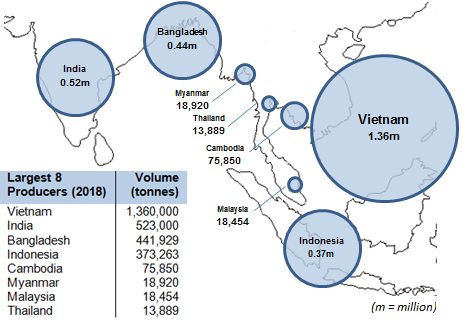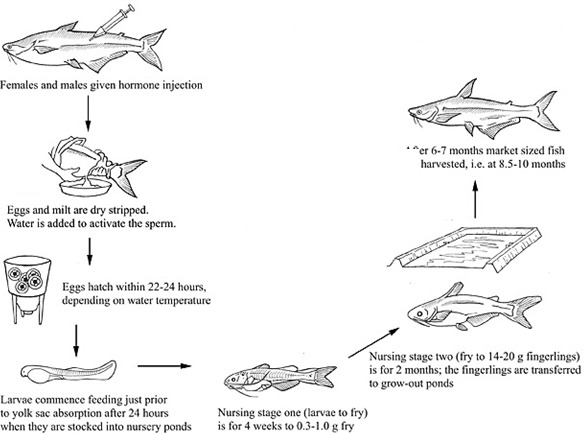Pangasius
Pangasianodon hypophthalmus
Sources, Quantities and Cultivation Methods
Source and Quantities
There are some 28 species within the family Pangasiidae1. Under UK fish labelling regulations2 any species of this family can be called pangasius, or panga(s), basa or river cobbler, and any of these names can be used along with the word ‘catfish’. Other names include swai, tra, cream dory, silver striped catfish, sutchi catfish and Vietnamese catfish. Pangasius were once an important freshwater fishery in the Mekong River3 but this has declined and wild populations are classified as endangered4.
Pangasius farming was traditionally small-scale and based on the capture of wild juveniles5. The development of artificial propagation techniques in the mid 1990’s led to the development of commercial hatcheries6, 7. Hatcheries greatly reduced the demand on wild seed and led to a rapid expansion of floating net-pen culture in Mekong Delta waterways. Net-pen farming has since declined and pangasius are now primarily reared in ponds8.
Pangasianodon hypophthalmus dominates pangasius farming and this is the species imported into Europe and the UK.
By 2012 pangasius production had increased to 2.4 million tonnes and has since remained relatively stable9. Vietnam continues to be at the centre of production. In Vietnam there are approximately 6,000 hectares of ponds producing 1.19 million tonnes of pangasius in 201610, with the majority of production coming from larger, integrated farms11.
Global pangasius production in 2018 was some 2.8 million tonnes, with a value of almost US$3.6 billion. As well as Vietnam, India, Bangladesh and Indonesia are main producers as the map shows. Caribbean nations such as Cuba, Jamaica and the Dominican Republic culture small volumes10.

Domestic Market Information
Our domestic seafood market is complex mix of products from wild caught and farmed species, including pangasius, which in recent years, has grown in popularity in Great British retail (i.e. in England, Scotland and Wales).
To discover more about the highly dynamic and ever-changing UK and Great British (GB) seafood marketplace, you can explore our user friendly and interactive Trade and Tariff in Tableau (T4) online tool. And visiting our dedicated Insight and Research pages will provide you with access to a wealth of information, from reports to factsheets on markets including:
- Retail – data from independent and multiple retailers in the UK used to reveal the latest insights on seafood eaten at home
- Foodservice – data from the foodservice industry in the UK used to highlight the latest trends on seafood eaten out of home
- Market supply – HM Revenue and Customs (HMRC) data used to detail what species and products are imported from, and exported to, the UK
To get the latest seafood market performance and trends delivered to your inbox, register at the Market Insight Portal.
Production method5
Pangasius broodstock are induced to spawn via hormonal injections. Larvae hatch after 24 hours, absorb the yolk-sac, and are then stocked in specially prepared ponds to feed on small crustaceans such as moina (a water flea). They are then fed supplementary feeds such as boiled egg and soya bean for the first two weeks, followed by commercial aquafeeds.
After one month, the fry are transferred to nursery ponds for a further two months. They are then transferred to grow-out ponds at 14-20 g, at stocking densities of 40-60 fish/m2. After a grow-out period of 6-7 months, the fish are harvested by partially draining the pond, netting and transfer to processing factories. Transfer for processing in areas such as the Mekong, is by well-boat (a vessel with wells or tanks for the storage or transport of live fish)5.

References
- Fish Base
- Defra
- Hall, A.S. and Johns, M., 2013. Assessment of the Vulnerability of the Mekong Delta Pangasius Industry to Development and Climate Change in the Lower Mekong Basin. Sustainable Fisheries Partnership, January, 2013
- IUCN
- FAO
- Sinh, L.X. and Hien, L.L., 2010. Supply and Use of Catfish (Pangasianodon hypophthalmus) Seed in the Mekong Delta of Vietnam. Aquaculture Asia magazine, Vol. XV, No. 1, Jan-Mar, 2010
- Cacot, P. et al, 2002. Induced ovulation of Pangasius bocourti (Sauvage, 1880) with a progressive hCG treatment. Aquaculture, Vol. 213, Iss. 1-4, 2002, p199-206
- De Silva, S.S. and Phuong, N.T., 2011. Striped Catfish Farming in the Mekong Delta, Vietnam: A Tumultuous Path to Global Success. Reviews in Aquaculture, 3, 2011, p45-73
- GOAL
- FAO FishStatJ
- Seafood TIP